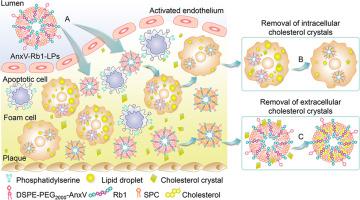Journal of Controlled Release ( IF 10.8 ) Pub Date : 2022-08-09 , DOI: 10.1016/j.jconrel.2022.07.021 Fanglin Gong 1 , Zibin Wang 1 , Rui Mo 1 , Yutong Wang 2 , Jin Su 1 , Xianglong Li 1 , Charos Tuychi Qizi Omonova 1 , Amari Mohamed Khamis 1 , Qing Zhang 3 , Mei Dong 4 , Zhigui Su 1

|
Atherosclerotic cardiovascular diseases remain the leading causes of morbidity and mortality worldwide. Cholesterol crystals in atherosclerotic plaques play an essential role in atherosclerosis progression. However, no clinical drugs have been used for removing cholesterol crystals from plaque to counter atherosclerosis. Previous studies identified the hydrophobic domain of lipid bilayer in liposomes acted as sinks for solubilizing hydrophobic cholesterol. Moreover, adjusting the composition of the lipid bilayer in liposomes can enhance its hydrophobic molecule loading capacity. Therefore, in this study, ginsenosides Rb1 (Rb1), one of main active components of ginseng which has a similar structure to cholesterol, is anchored into soy phospholipids bilayer with its hydrophobic region to prepare nano-sponge-like liposomes (Rb1-LPs), aiming to amplify the solubilization of cholesterol in lipid bilayer. For targeting delivery to atherosclerotic plaques, Annexin V (AnxV), a protein that can specifically recognize phosphatidylserine upregulated in atherosclerotic plaques, is applied to decorate the surface of Rb1-LPs by click reaction to obtain the final preparation of AnxV-Rb1-LPs. The in vitro studies showed that incorporating Rb1 into lipid bilayer remarkably increased the affinity of the lipid bilayer to free cholesterol and the solubilization of cholesterol crystals. Additionally, nano-sponge-like liposomes could efficiently reduce the accumulation of cholesterol crystals and improve cholesterol efflux, finally inhibiting inflammation and apoptosis in cholesterol-laden cells. Furthermore, AnxV-Rb1-LPs could efficiently accumulate in atherosclerotic plaques after intravenous injection, exert nano-sponge-like functions to remove intra- and extracellular cholesterol crystals, ultimately alleviating inflammation and apoptosis in atherosclerotic plaques for antiatherosclerosis. Therefore, AnxV-Rb1-LPs provide a potential strategy for removing cholesterol crystals in atherosclerotic plaques and can be further utilized in other diseases with excessive cholesterol accumulation.
中文翻译:

纳米海绵状脂质体去除胆固醇晶体以抗动脉粥样硬化
动脉粥样硬化性心血管疾病仍然是全球发病率和死亡率的主要原因。动脉粥样硬化斑块中的胆固醇晶体在动脉粥样硬化进展中起重要作用。然而,还没有临床药物用于从斑块中去除胆固醇晶体以对抗动脉粥样硬化。以前的研究确定了脂质体中脂质双层的疏水结构域作为溶解疏水性胆固醇的汇。此外,调整脂质体中脂质双层的组成可以增强其疏水分子负载能力。因此,本研究将人参主要活性成分之一的人参皂苷Rb1(Rb1)与胆固醇结构相似,锚定在大豆磷脂双分子层的疏水区,制备纳米海绵状脂质体(Rb1-LPs)。 , 旨在增强脂质双层中胆固醇的溶解度。为了靶向递送至动脉粥样硬化斑块,膜联蛋白V(AnxV)是一种可特异性识别动脉粥样硬化斑块中上调的磷脂酰丝氨酸的蛋白质,通过点击反应修饰Rb1-LPs表面,得到AnxV-Rb1-LPs的最终制剂。这体外研究表明,将 Rb1 掺入脂质双分子层显着增加了脂质双分子层对游离胆固醇的亲和力和胆固醇晶体的溶解。此外,纳米海绵状脂质体可以有效减少胆固醇晶体的积累,改善胆固醇外流,最终抑制胆固醇负载细胞的炎症和凋亡。此外,AnxV-Rb1-LPs 可在静脉注射后有效积聚在动脉粥样硬化斑块中,发挥纳米海绵样功能,去除细胞内外胆固醇晶体,最终缓解动脉粥样硬化斑块的炎症和细胞凋亡,从而起到抗动脉粥样硬化的作用。所以,


























 京公网安备 11010802027423号
京公网安备 11010802027423号